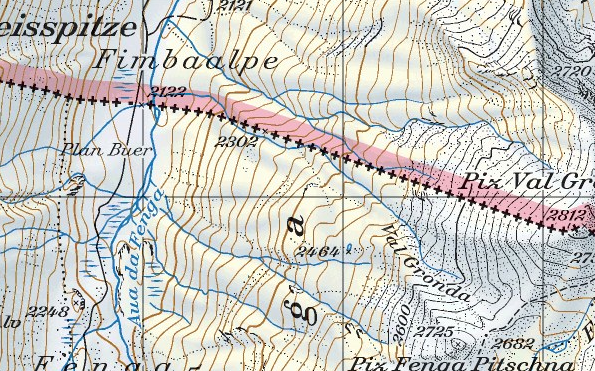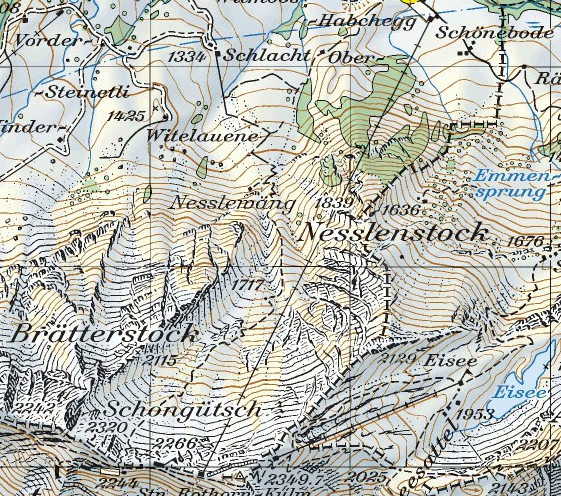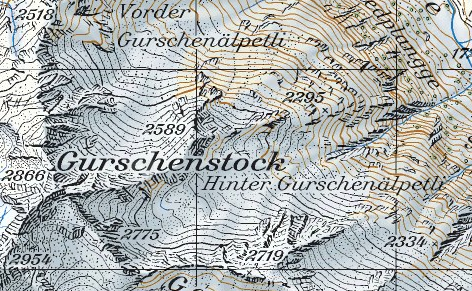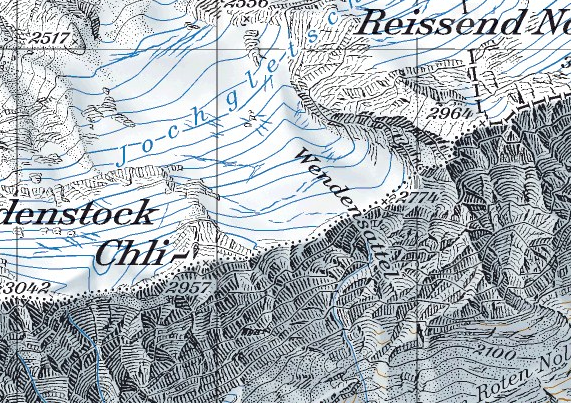Welche Hänge zu einem bestimmten Zeitpunkt befahren werden können, darüber entscheidet neben dem Fahrkönnen der beteiligten Wintersportler zuerst einmal die Lawinengefahr. Werner Munters Motto "Je steiler umso geiler, desto schneller löst sich die Lawine" bringt?s auf den Punkt: Wir Freerider müssen unsere Geländewahl vor allem der Lawinensituation anpassen.
Die Lawinengefahr entscheidet, welche Touren und Abfahrten möglich sind
Je höher die Lawinengefahr, umso ungünstiger ist die Schneedecke aufgebaut und umso defensiver muss das Gelände gewählt werden. Kurz gesagt: niedrige Lawinengefahr und günstige Schneeverhältnisse bedeuten: steiles Gelände kann gewählt werden. Hohe Lawinengefahr und ungünstige Schneesituation heißt: ich beschränke mich auf mäßig steiles oder sogar flaches Gelände.
3x3-Filter- und Reduktionsmethoden als Entscheidungsgrundlage
Die heute angewendeten verschiedenen Risiko-Check Methoden, gehen auf die revolutionären Arbeiten des Lawinenexperten Werner Munter zurück bzw. bauen auf diesen auf. Diese Risko-Checks sind heute die Grundlage für vernünftige Entscheidungen risikobewusster Wintersportler, die mit dem Lawinenproblem nicht im Stil russischen Roulettes umgehen wollen. Die bekanntesten Methoden sind: 3x3-Filter, Reduktionsmethode, SnowCard, Goldene Regel und Bierdeckel-Schnellcheck. Wer in diesen Methoden noch nicht Firm ist, findet eine Kurzbeschreibung dieser Risiko-Check-Methoden als Link.
Zur Vorbereitung von Touren und Freeride-Tagen eignet sich insbesondere die 3x3-Filtermethode. Diese beurteilt die Faktoren “Verhältnisse” (Lawinen, Schnee, Wetter), “Gelände” und “Mensch” und ermöglicht eine einfache, aber professionelle und risikooptimierte Planung. Zusätzlich beeinflussen sich die Faktoren natürlich gegenseitig und müssen in der Schlussplanung miteinander harmonieren.
Der Faktor Mensch
Natürlich muss eine Tour den körperlichen und geistigen Fähigkeiten der Gruppe angepasst sein. So selbstverständlich diese Aussage ist, so verheerend ist die Fehlplanung. Selbst die gemütlichste Tour wird zum Desaster, wenn ein Gruppenmitglied in der Schlüsselstelle probleme bekommt, am Grat die Angst eintritt, oder am Ende die Körner fehlen.
Der Faktor Wetter
Auch das Wetter mus zur Tour passen. So kann man leichte Touren nicht weit über die Baumgrenze bei günstiger Lawinenlage durchaus auch bei schlechterem Wetter machen. Sobald aber das Gelände eine diffizilere Orientierung erfordert, oder die Lawinenlage verlangt, dass man die umliegenden Hänge beurteilen kann, sinkt die Schlechtwettertoleranz erheblich. Wie alle anderen Faktoren auch, muss also das Wetter zu den Gegebenheiten und zur Planung passen.
Der Faktor Lawinen
1. Die aktuelle und voraussichtliche Lawinenwarnstufe für das betreffende Gebiet.
2. Die maximale Hangneigung der zu befahrenden Abfahrt bzw. Tour. Achtung: je höher die Lawinengefahr ist, umso großflächiger muss die Lawinengefahr des umgebenden Geländes in der Gefahreneinschätzung beurteilt werden. Aufgrund der Möglichkeit von Fernauslösungen muss dann der gesamte Hangabschnitt berücksichtigt werden.
3. Ebenfalls sehr wichtig für die Einschättzung des Risikos einer Abfahrt oder Tour ist deren Exposition(en), das heißt, die Himmelsrichtung in die der Hang bzw. die Hänge geneigt sind.
4. Die Anzahl und das Können der beteiligten Wintersportler.
Lawinengefahr und Schneedeckeninfos
Die Lawinenwarnstufe beschreibt die allgemeine Gefährdung durch Lawinen. Die Zusatzinfos, also das “Kleingedrucke” verraten, welche Hänge eher günstig und welche Hänge besonders risikoträchtig sind.
Hangneigung, Hangexposition und Geländeformationen
Die Hangneigung lässt sich im Gelände messen oder schätzen, doch dann ist es für eine vorausschauende Tourenplanung zu spät. Besonders bewährt haben sich zur Touren- und Freeride-Planung topografische Karten im großen Maßstab (1:25.000). Mit Hilfe solcher Karten ist es ein Leichtes, die Hangneigung, Hangform und -Exposition nahezu jedes Geländeabschnittes zuverlässig zu bestimmen. Wie das geht? Eine Einführung zum Hangneigungsmessen in der Karte findet ihr hier…
Die Gruppengröße
Je mehr Wintersportler die Schneedecke an einem Punkt belasten, umso höher ist die Wahrscheinlichkeit eine Lawine auszulösen. Aus diesem Grund sind große Gruppen nicht nur schwierig in der Gruppenorganisation, weil man sich entweder ständig in die Quere kommt oder sehr viel warten muss, sondern auch, weil die Wahrscheinlichkeit, eine Lawine auszulösen, ebenfalls ansteigt. Dies trifft insbesondere bei eher ungünstigen Lawinenverhältnissen zu, wohingegen bei geringer Lawinengefahr (Stufe 1) wenig dagegen spricht, auch mal als größere Gruppe einen Backcountry-Ausflug zu unternehmen.
Der Faktor Gelände
Geländeformen
Einige wichtige Geländeformen sollte jeder Freerider kennen. Neben dem Erkennen typischer Geländefallen geht es auch darum, die besonders geeigneten, also sozusagen die Gelände-Leckerbissen bereits im Voraus zu erkennen, um zu entscheiden, ob sich eine Tour oder ein Gebiet besonders lohnt.
Gefahrenstellen
Ungegliederte SteilhängeUngegliederte, extreme Steilhänge, die steiler sind als 39° Neigung, gehören zu den besonders kritischen Geländeformen. Mangels ausgeprägter Geländestrukturen ist die Schneedecke schwach abgestützt. Vor allem bei hohen Gefahrenstufen lösen sich hier oftmals große Lawinen.
Geländefallen: Mulden, Gräben, Senken, Flachstücke
Tief eingeschnittene Gräben, ausgeprägte Mulden und Senken sowie Flachstücke unterhalb von Steilhängen können zur tödlichen Falle werden. Insbesondere in Mulden oder Bachläufen können schon vergleichsweise kleine Lawinen zu sehr tiefen Verschüttungen führen.
Wartepunkte sollten möglichst nie im Flachen am Ende von Steilhängen gewählt werden, weil man im Falle einer Lawinenauslösung von oberhalb sehr nur geringe Chancen hat, zu entkommen.
Rinnen
Viele Hänge, vor allem in felsigem Terrain sind von Rinnen und Rücken durchzogen. Während die Felsformationen oft nur wenig oder gar nicht mit Schnee bedeckt sind, befindet sich oftmals viel Triebschnee in den Rinnen, sodass diese, vor allem nach Neuschnee unter Windeinfluss, immer mit Vorsicht zu genießen sind. Achtung: Rinnen sind Lawinenbahnen.
Steilhänge hinter Geländeeinschnitten (Sättel)
Steilhänge hinter Geländeeinschnitten und Sätteln im Lee (Windschatten) gehören zu den typischen Stellen, an denen Lawinen ausgelöst und Wintersportler verschütet werden. Die Geländeeinschnitte bewirken häufig einen Düseneffekt, wodurch auf der Windschattenseite solcher Einsattelungen oftmals große Mengen Triebschnee abgelagert werden.
Steilhänge mit Felsabbrüchen
Steilhänge, die größere Felsabbrüche aufweisen, sind risikoreich und ungünstig zu bewerten: Die Schneedecke ist kaum abgestützt und kann dadurch leichter gestört werden. Hinzu kommt die Absturzgefahr im Falle einer Lawinenauslösung oder bei einem Sturz.
Gletscher
Beim Freeriden im Hochgebirge befindet man sich häufig im vergletscherten Gelände. In schneearmen Wintern sowie generell im Früh- und Hochwinter sind die Spalten oftmals nur dünn mit Schnee bedeckt und die Spaltensturzgefahr ist hoch. Ortskenntnis ist hier ein entscheidender Vorteil. Wenn man die Positionen der Spaltenzonen kennt, kann man auch auf Gletschern – gute Sicht vorausgesetzt – meist gut und ohne allzu hohes Risiko unterwegs sein. Achtung: Gletschertouren bzw. -abfahrten erfordern neben der entsprechenden Ausrüstung (Seil, Gurt, Karabiner, Schlingen, Eisschraube) das entsprechende Know-how für die Spaltenbergung.
Nicht einsehbares Gelände
Im extremen Steilgelände sind die meisten Abfahrten nicht auf ganzer Länge einsehbar, was die Navigation entscheidend erschwert und auch die Absprachen innerhalb der Gruppe sehr schwierig macht.
Besonders lohnendes und risikobegünstigtes Gelände
Kupiertes Gelände
Kupiertes Gelände bietet zumeist gute Möglichkeiten, auch bei angespannter Lawinensituation vergleichsweise günstige Aufstiegs- und Abfahrtsrouten zu finden. Hier sollten man jedoch darauf achten, dass auf kleinster Fläche die Hangneigung sowie die -Exposition laufend wechseln und günstige und gefährliche Bereiche kleinräumig unmittelbar aneinander grenzen können. Optisch erweckt solches Gelände den trügerischen Eindruck lawinensicher zu sein. Doch bereits mittelgroße Lawinen können gestuftes oder kupiertes Gelände überspülen und dann können die Mulden zur tödlichen Falle werden.
Rücken
Auf Rücken liegt fast immer deutlich weniger Schnee als in Mulden und Rinnen. Daher findet man hier, vor allem bei angespannten Lawinensituationen oftmals wesentlich risikoärmere Aufstiegs- und Abfahrtsmöglichkeiten. Allerdings ist dort das Abfahrtsvergnügen oft eher eingeschränkt.
Eine Sondersituation sind sehr schneereiche Winter, wie der aktuelle Winter 2012: da die Schneedecke auf den Rücken weniger mächtig ist, können eventuell vorhandene Schwachschichten in der Schneedecke im Bereich der dünnen Schneedecke leichter gestört werden und hierdurch Lawinen ausgelöst werden. Im Bereich sehr dicker Schneedecken können tief gelegene Schwachschichten von Wintersportlern meist kaum mehr gestört werden. Solche Sondersituationen werden jedoch meist im Lawinenlagebericht genannt. Siehe hierzu das „Kleingedruckte“.
Weitläufiges, mäßig steiles Gelände
Weitläufiges, mäßig steiles Gelände kann häufig auch bei kritischer Lawinensituation befahren werden, vorausgesetzt es befindet sich nicht im Auslauf- bzw. Einzugsbereich gefährliche Lawinenhänge. Perfektes Gelände, um einfach mal Vollgas zu fahren, oder ganz entspannt aufzusteigen. Solche Hänge sind zwar nichts für Adrenalin-Freaks, aber eben total entspannend und das nicht nur, weil hier die Lawinengefahr meist viel entspannter ist…
Flach auslaufende, sich weitende Hänge
Steilhänge, die sich nach unten weiten und flach auslaufen sind günstiger als Hänge oder Couloirs, die beispielsweise in Gräben oder Engstellen enden (siehe hierzu den Abschnitt Geländefallen).
Im Falle eines Lawinenabgangs dürfte die Lawinenablagerung am flachen Hangfuß weniger mächtig sein, sodass Verschüttete hier oftmals weniger tief oder nur teilverschüttet oder sogar überhaupt nicht verschüttet werden.
„Safe Spots“ und „Inseln der Sicherheit“
Auch wenn man im winterlichen Gebirge das Wort „Sicherheit“ mit allergrößter Zurückhaltung benutzen sollte, verrät der Ausdruck zumindest, nach welchen Kriterien Haltepunkte oder Sammelplätze ausgesucht werden sollten. Noch immer sieht man zu viele Wintersportler, die in riskanten Steihängen anhalten, um dort zu warten. Günstige Halteplätze findet man auf erhöhten Kuppen, im Schutz großer Felsen oder auf Rücken mit Abstand zum lawinengefährdeten Gelände.
Führerliteratur und (Spezial-)Karten als Planungsinstrument
Ein besonders sinnvolles Vorbereitungstool für Skitouren sind die Beschreibungen aus Skitouren- oder Freerideführern sowie diverse Spezialkarten wie die Freeride Maps oder die Schweizer Skitourenkarten. Gut recherchierte Führerliteratur bietet nicht nur tolle Skitourenvorschläge, sondern man erhält darüber hinaus wertvolle Hinweise zu Gefahrenstellen und Tipps zu besonderen Schmankerln.
Die seit einigen Jahren erhältlichen Freeride Maps kennzeichnen grob das für Freerider fahrbare Gelände in den jeweiligen Gebieten. Skitourenkarten, z.B. die sehr empfehlenswerten Schweizer 1:50.000 Skitourenkarten von Swiss Topo bieten nicht nur die legendäre Qualität der Schweizer Karten, sondern darüber hinaus sind nahezu alle Skitouren eingezeichnet, die zusätzlich auch in den Tourenführern des Schweizer Alpenclubs (SAC) beschrieben werden.
Viel Spaß und Erfolg bei der Tourenplanung wünschtDie Mountain Mastery Crew














